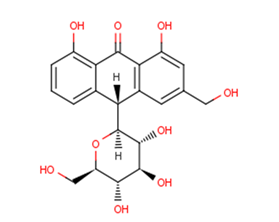
Aloin B
CAS No. 28371-16-6
Aloin B( Aloin B | 10-epi-Aloin A | Isobarbaloin )
Catalog No. M18361 CAS No. 28371-16-6
The extract of A. vera and its active ingredient aloin cause melanin aggregation leading to skin lightening via alpha adrenergic receptor stimulation.
Purity : >98% (HPLC)
 COA
COA
 Datasheet
Datasheet
 HNMR
HNMR
 HPLC
HPLC
 MSDS
MSDS
 Handing Instructions
Handing Instructions
| Size | Price / USD | Stock | Quantity |
| 5MG | 79 | In Stock |


|
| 10MG | 138 | In Stock |


|
| 25MG | 232 | In Stock |


|
| 50MG | 352 | In Stock |


|
| 100MG | 538 | In Stock |


|
| 200MG | Get Quote | In Stock |


|
| 500MG | Get Quote | In Stock |


|
| 1G | Get Quote | In Stock |


|
Biological Information
-
Product NameAloin B
-
NoteResearch use only, not for human use.
-
Brief DescriptionThe extract of A. vera and its active ingredient aloin cause melanin aggregation leading to skin lightening via alpha adrenergic receptor stimulation.
-
DescriptionThe extract of A. vera and its active ingredient aloin cause melanin aggregation leading to skin lightening via alpha adrenergic receptor stimulation, the result opens new vistas for the use of A. vera regarding its clinical application as a new nontoxic melanolytic agent for the treatment of hyperpigmentation. Dietary supplementation of aloe components (aloin, aloesin and aloe-gel) can ameliorate intestinal inflammatory responses in a 3% dextran sulfate sodium (DSS)-induced ulcerative colitis rat model, in particular, aloesin is the most potent inhibitor.
-
In Vitro——
-
In Vivo——
-
SynonymsAloin B | 10-epi-Aloin A | Isobarbaloin
-
PathwayOthers
-
TargetOther Targets
-
RecptorOthers
-
Research AreaOthers-Field
-
Indication——
Chemical Information
-
CAS Number28371-16-6
-
Formula Weight418.39
-
Molecular FormulaC21H22O9
-
Purity>98% (HPLC)
-
SolubilityDMSO : ≥ 100 mg/mL; 239.01 mM
-
SMILESC1=CC2=C(C(=C1)O)C(=O)C3=C(C=C(C=C3C2C4C(C(C(C(O4)CO)O)O)O)CO)O
-
Chemical Name10R-beta-D-glucopyranosyl-1,8-dihydroxy-3-(hydroxymethyl)-9(10H)-anthracenone
Shipping & Storage Information
-
Storage(-20℃)
-
ShippingWith Ice Pack
-
Stability≥ 2 years
Reference
molnova catalog



related products
-
1-Methoxycarbonyl-be...
1-Methoxycarbonyl-β-carboline is an alkaloid from Ailanthus altissima.
-
Atrial Natriuretic F...
Anaritide is a synthetic form of atrial natriuretic peptide (ANP) composed of 25 amino acids. Anaritide increases glomerular filtration rate by dilating into and contracting out the bulbar arterioles. Anaritide can be used to study the effects on patients with acute tubular necrosis, particularly in improving dialysis free survival.
-
Thymalfasin
Thymalfasin (thymosin-alpha 1) is an immunomodulating agent able to enhance the Thl immune response.



 Cart
Cart
 sales@molnova.com
sales@molnova.com


